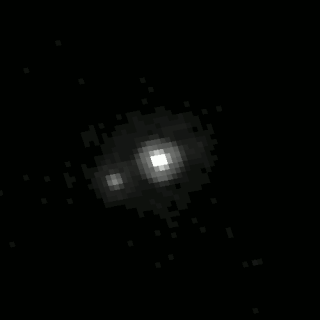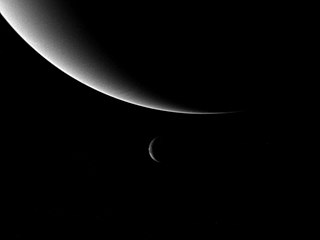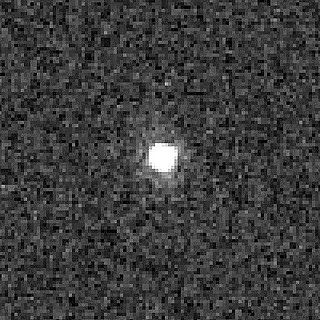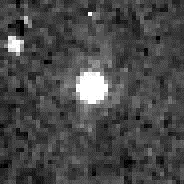
28978 Ixion (, provisional designation 2001 KX76) is a large trans-Neptunian object and a possible dwarf planet. It is located in the Kuiper belt, a region of icy objects orbiting beyond Neptune in the outer Solar System. Ixion is classified as a plutino, a dynamical class of objects in a 2:3 orbital resonance with Neptune. It was discovered in May 2001 by astronomers of the Deep Ecliptic Survey at the Cerro Tololo Inter-American Observatory, and was announced in July 2001. The object is named after the Greek mythological figure Ixion, who was a king of the Lapiths.

Orcus is a trans-Neptunian dwarf planet with a large moon, Vanth. It has a diameter of 870 to 960 km, the size of or somewhat smaller than the asteroid Ceres. The surface of Orcus is relatively bright with albedo reaching 23 percent, neutral in color and rich in water ice. The ice is predominantly in crystalline form, which may be related to past cryovolcanic activity. Other compounds like methane or ammonia may also be present on its surface. Orcus was discovered by American astronomers Michael Brown, Chad Trujillo, and David Rabinowitz on 17 February 2004.

The definition of planet has changed several times since the word was coined by the ancient Greeks. Greek astronomers employed the term ἀστέρες πλανῆται, 'wandering stars', for star-like objects which apparently moved over the sky. Over the millennia, the term has included a variety of different celestial bodies, from the Sun and the Moon to satellites and asteroids.

The University of the Republic is Uruguay's oldest public university. It is by far the country's largest university, as well as the second largest public university in South America and the world's 57th largest by enrollment, with a student body of 137,757 undergraduate students in 2018 and 6,351 postgraduate students in 2012. It was founded on 18 July 1849 in Montevideo, where most of its buildings and facilities are still located. Its current rector is Rodrigo Arim.
(15874) 1996 TL66, provisional designation 1996 TL66, is a trans-Neptunian object of the scattered disc orbiting in the outermost region of the Solar System.
(26375) 1999 DE9 (also written (26375) 1999 DE9) is a trans-Neptunian object. Light-curve-amplitude analysis shows only small deviations, suggesting (26375) 1999 DE9 is a spheroid with small albedo spots. Measurements by the Spitzer Space Telescope estimate that it is 461 ± 45 km in diameter. It was discovered in 1999 by Chad Trujillo and Jane X. Luu. It is possibly a dwarf planet.

38628 Huya ( hoo-YAH), provisional designation 2000 EB173, is a binary trans-Neptunian object located in the Kuiper belt, a region of icy objects orbiting beyond Neptune in the outer Solar System. Huya is classified as a plutino, a dynamical class of trans-Neptunian objects with orbits in a 3:2 orbital resonance with Neptune. It was discovered by the Quasar Equatorial Survey Team and was identified by Venezuelan astronomer Ignacio Ferrín in March 2000. It is named after Juyá, the mythological rain god of the Wayuu people native to South America.

(90568) 2004 GV9 is a trans-Neptunian object that was discovered on April 13, 2004 by NEAT. It has been listed as a cubewano by the Minor Planet Center. It was discovered on 13 April 2004 by NEAT. It has been observed forty-seven times, with precovery images back to 1954. The object has an orbital period of 273.88 years. Its maximum possible distance from the Sun (aphelion) is 45.62 AU, and its closest (perihelion) is 38.7 AU, and currently 39.7 AU from he sun. It has an inclination of 21.9718, and eccentricity of 0.082.

(55565) 2002 AW197 is a classical, non-resonant trans-Neptunian object from the Kuiper belt in the outermost region of the Solar System, also known as a cubewano. With a likely diameter of at least 700 kilometers (430 miles), it is approximately tied with 2002 MS4 and 2013 FY27 (to within measurement uncertainties) as the largest unnamed object in the Solar System. It was discovered at Palomar Observatory in 2002.

A dwarf planet is a small planetary-mass object that is in direct orbit of the Sun, smaller than any of the eight classical planets but still a world in its own right. The prototypical dwarf planet is Pluto. The interest of dwarf planets to planetary geologists is that they may be geologically active bodies, an expectation that was borne out in 2015 by the Dawn mission to Ceres and the New Horizons mission to Pluto.

The International Astronomical Union (IAU) defined in August 2006 that, in the Solar System, a planet is a celestial body that:
- is in orbit around the Sun,
- has sufficient mass to assume hydrostatic equilibrium, and
- has "cleared the neighbourhood" around its orbit.

(145452) 2005 RN43, also written as (145452) 2005 RN43, is a classical Kuiper belt object. It has an estimated diameter of 679+55
−73 km. It was discovered by Andrew Becker, Andrew Puckett and Jeremy Kubica on 10 September 2005 at Apache Point Observatory in Sunspot, New Mexico. Brown estimates that it is possibly a dwarf planet.

(84922) 2003 VS2 is a trans-Neptunian object discovered by the Near Earth Asteroid Tracking program on 14 November 2003. Like Pluto, it is in a 2:3 orbital resonance with Neptune and is thus a plutino. Analysis of light-curve suggests that it is not a dwarf planet.

(469372) 2001 QF298, provisionally known as 2001 QF298, is a resonant trans-Neptunian object that resides in the Kuiper belt in the outermost region of the Solar System. It was discovered on August 19, 2001 by Marc W. Buie. 2001 QF298 is a plutino, meaning that it is locked in a 3:2 orbital resonance with Neptune, much like Pluto.
(120348) 2004 TY364, provisionally known as 2004 TY364, is a trans-Neptunian object. It is an inner classical Kuiper belt object in the definition by Gladman, Marsden, and Van Laerhoven (e<0.24). Its inclination of almost 25 degrees disqualifies it as such in Marc Buie's definition. It is also not listed as a scattered disc object by the Minor Planet Center. It was discovered by Michael E. Brown, Chad Trujillo and David L. Rabinowitz on October 3, 2004 at the Palomar Observatory.

Julio Ángel Fernández Alves is a Uruguayan astronomer and teacher, member of the department of astronomy at the Universidad de la República in Montevideo. He is also a member of PEDECIBA,, and the Uruguayan Society of Astronomy. From 2005 to 2010, he was the Dean of the Universidad de la Republica's Faculty of Sciences. The asteroid 5996 Julioangel, discovered in 1983, was named after him.
5088 Tancredi, provisional designation 1979 QZ1, is a carbonaceous Themistian asteroid from the outer region of the asteroid belt, approximately 15 kilometers in diameter. It was discovered on 22 August 1979, by Swedish astronomer Claes-Ingvar Lagerkvist at ESO's La Silla Observatory in northern Chile. It is named after Uruguayan astronomer Gonzalo Tancredi.

Gladys Elena Vergara Gavagnin was a Uruguayan astronomer and professor, known for her calculations on eclipses, made during a time when computers were not capable of them. The asteroid 5659 Vergara is named in her honor.
The International Union of Geological Sciences (IUGS) is the internationally recognized body charged with fostering agreement on nomenclature and classification across geoscientific disciplines. However, they have yet to create a formal definition of the term planet. As a result, there are various geophysical definitions in use among professional geophysicists, planetary scientists, and other professionals in the geosciences. Many professionals opt to use one of several of these geophysical definitions instead of the definition voted on by the International Astronomical Union.














